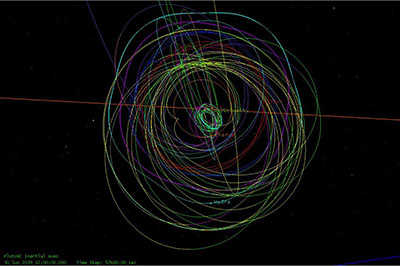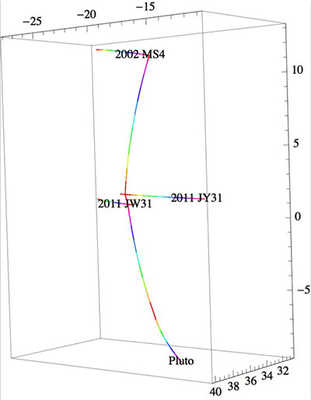Background
 Figure 1: Schematic of Pluto orbital mission tour. This mission would orbit Pluto for two years, with multiple flybys of each of Pluto's moons before exiting the Pluto system to fly by other objects in the Kuiper belt.
Figure 1: Schematic of Pluto orbital mission tour. This mission would orbit Pluto for two years, with multiple flybys of each of Pluto's moons before exiting the Pluto system to fly by other objects in the Kuiper belt. NASA's New Horizons mission, led by an SwRI PI, has shown the scientific value of Kuiper Belt exploration, and has sparked an interest in missions that return to Pluto and the Kuiper Belt. The purpose of this project was to develop tools for and then explore a wide range of potential Pluto-Kuiper Belt Missions to select strong candidate missions to propose to NASA for studies in 2018 as a ramp up to the next Planetary Decadal Survey, as well as inform NASA advisory committees and the general planetary science community of opportunities and strawman designs.
Approach
 Figure 2: Flight path for a spacecraft leaving Pluto for KBO 2002 MS4. The spacecraft could visit two additional objects - 2011 KY31 and 2011 JW31 en route.
Figure 2: Flight path for a spacecraft leaving Pluto for KBO 2002 MS4. The spacecraft could visit two additional objects - 2011 KY31 and 2011 JW31 en route. The goals of the project were to develop and exploit mission analysis tools, as well as study a "gold standard" nuclear-electric propulsion mission that would orbit Pluto and visit other Kuiper Belt Objects. A mass mission search tool has been developed based on a previous prototype. Additional development work has been performed to study Kuiper Belt Objects accessible after a Pluto orbiter. For the Pluto orbiter itself, design work has been performed using commercial spacecraft trajectory analysis software.
Accomplishments
A "gold standard" mission model for a two-year orbital tour of Pluto has been created (see Figure 1). Additionally, post-Pluto follow-on targets reachable in a 20-year mission lifetime have been identified, including multiple flyby opportunities (see Figure 2). The combined orbiter/KBO flyby mission was presented in a special workshop at the 2018 Division for Planetary Sciences meeting in Knoxville, Tennessee.
Using the software tools developed as part of this project, mission searches using several flyby configurations involving Jupiter, Saturn, Uranus and Neptune were conducted for the 45 brightest KBOs and Pluto. A peer-reviewed article summarizing the mission search was accepted by the Journal of Spacecraft and Rockets in 2018. It has also been posted on the Cornell University ArXiV servers.
